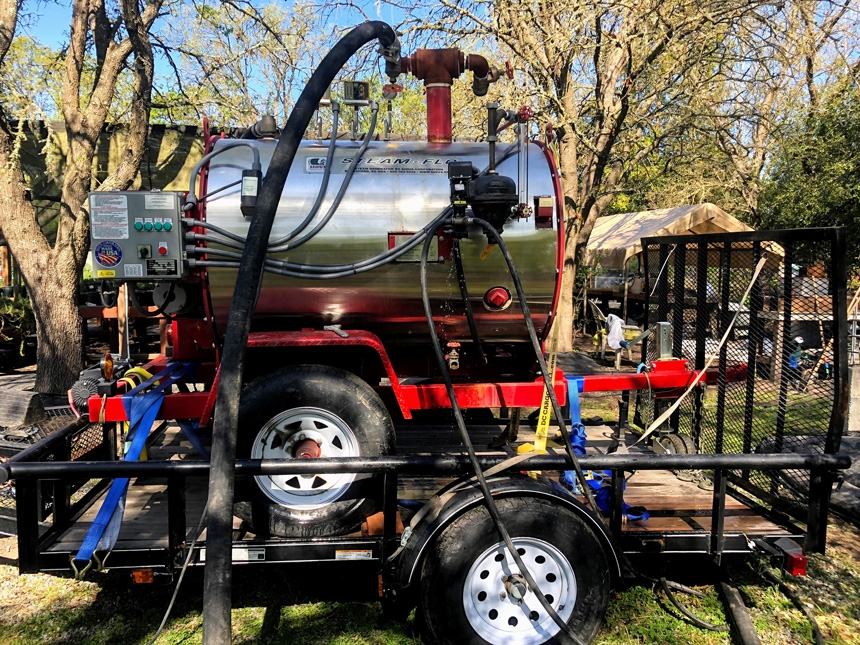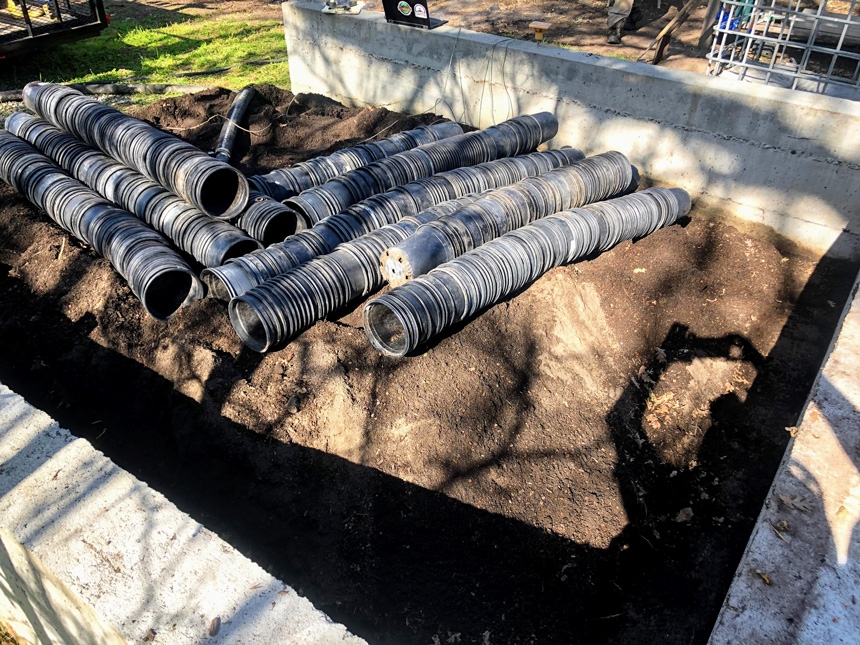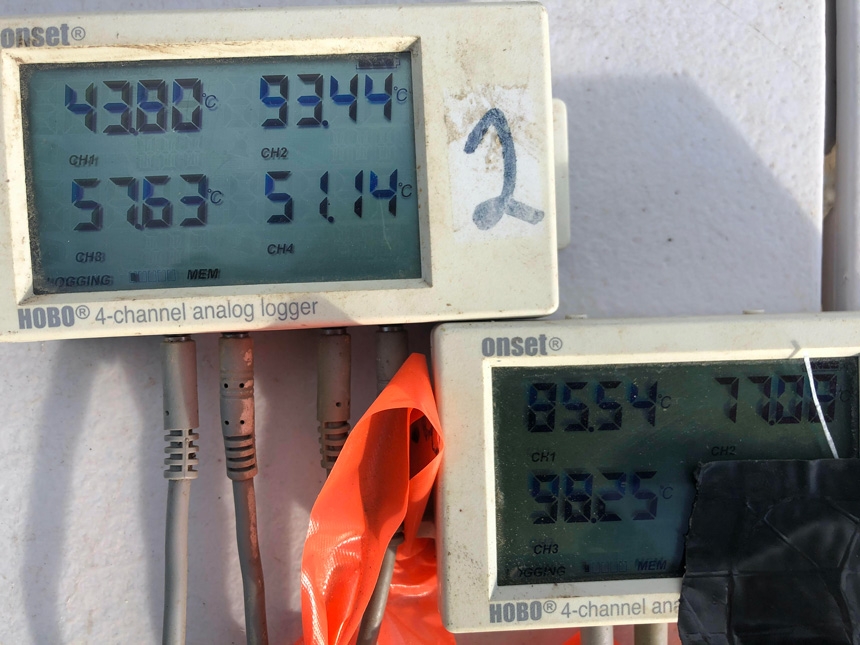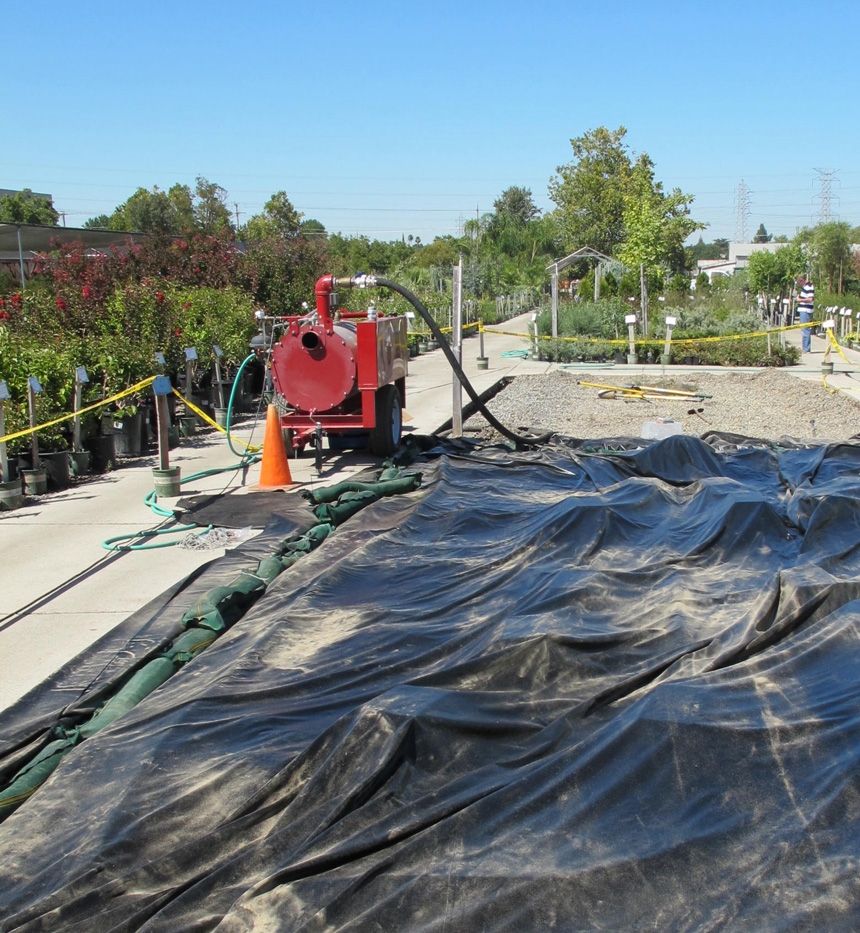
SOD Blitz Marin County, April 25-27, 2025
The NORS-DUC team will organize the annual SOD Blitz in Marin Co. from April 25-27, 2025. The SOD Blitz is an annual “citizen science” event, organized by Professor Matteo Garbelotto and his team from UC Berkeley together with local partners at different locations along coastal California. SOD-blitzes inform and educate the community about Sudden Oak Death, get locals involved in detecting the disease, and produce a detailed web-based map of disease distribution. The map can then be used to identify those areas where the infestation may be mild enough to justify proactive management. The SOD Blitz is one of the biggest citizen science events in forest pathology worldwide! Learn more about SOD Blitz here.
For more information, email Wolfgang Schweigkofler at wolfgang.schweigkofler@dominican.edu
Studies on the epidemiology and spread of Boxwood blight
Boxwood blight, caused by the fungi Calonectria pseudonaviculata (Cps) and Calonectria henricotiae (only found in Europe thus far), is a very aggressive invasive disease which is hard to control and devastated already many gardens in Europe and the Eastern US in recent years. So far, Boxwood blight has only rarely found on the West coast and little is known about transmission and spreading of Cps in the Western US and the effect of local climate on it. Our long-term experiments will help to improve our knowledge on the epidemiology of the disease and will lead to better prediction models and control strategies.
Steaming on the go
Heat treatment is a well-established method for the mitigation of plant pathogens. At NORS-DUC we use steaming for the decontamination of research plots in which experiments with Phytophthora ramorum or other quarantine pathogens were conducted. Heat treatment at a temperature of 50⁰C for 30 minutes will kill P. ramorum (Schweigkofler et al. 2014). Based on research done at NORS-DUC, USDA APHIS accepted steaming as an official treatment for nursery soil infested with P. ramorum. Steaming is now an established part of the Best Management Practices (BMP) in several nurseries in and outside of California. Steaming can be used to mitigate existing soil beds in situ, but also potting mixes, pots, and other nursery equipment and will reduce the risk of establishment and transmission of plant diseases.
For the past several years, NORS-DUC offers steaming services for nurseries and other interested parties in the San Francisco Bay Area and surrounding counties. NORS-DUC brings its own equipment, including a SIOUX SF-20 steam engine and temperature sensors, to the treatment site, and will plan, set up, conduct, and monitor the steaming event. NORS-DUC can also help with designing a site-specific manifold for improved soil steaming. (Please see photo gallery below.)
For more information, please contact Vernon Huffman, NORS-DUC nursery manager.
Lateral movement of Phytophthora ramorum in nursery substrates
Gary Chastagner and Marianne Elliott, Washington State University, WA
The primary purpose of this project is to determine lateral spread of P. ramorum from pot leachate through nursery substrates and to inform managers about the optimal distance for implementing control actions to prevent the spread of P. ramorum inoculum through three nursery bed substrates: gravel, soil, and soil covered with weed cloth. Recent requirements for the destruction and quarantine radius surrounding plants that are confirmed infected are 2m and 4m, respectively (USDA 2020). This project will determine if these radii are sufficient for common nursery substrates.
Using steam and solarization treatments to control wood-boring insects
Vernon Huffman and W. Schweigkofler, NORS-DUC, CA; Sheri Smith, USDA Forest Service; in collaboration with CalFire and CDFA
The project will use heat treatment to mitigate wood infested by the Mediterranean oak beetle (MOB). The Mediterranean Oak Borer (Xyleborus monographus) is an invasive ambrosia beetle attacking mature Valley Oaks (Quercus lobata) in Northern California, esp. Napa and Sacramento Valley. Infested trees show symptoms including wilting, defoliation, and broken branches. The insect seems to prefer trees which are already weakened by water stress or other pests or pathogens. Treatment of felled, but still infested trees is necessary to limit pest spread and population size, but can be expensive, difficult, or have negative impacts on the environment (e.g., when insecticides are used). Steaming and solarization are two potential alternative methods to treat heavily infested trees and can be used as part of an integrated pest management plan. We will test different wood sizes (wood chips, branches, main stems) and develop protocols for successful heat treatment of wood.
Advanced technology for detection and identification of Phytophthora species in U.S. nurseries
Doug Luster, USDA Ft. Detrick, MD; Karen Suslow, NORS-DUC, CA; Gary Chastagner, Washington State University, WA; Chaunxe Hong, Virginia Tech, VA; Monique Sakilidas, Michigan State University, MI; and Andrew Flannary, PathSensors, MD.
We propose to develop a rapid “triage” approach for detection and identification of multiple Phytophthora species in nurseries using new technologies. We will test a dual-technology, proof-of-concept system utilizing the CANARY (Cellular Analysis and Notification of Antigen Risks and Yields) Phytophthora biosensor for rapid detection at the generic level, coupled with loop mediated isothermal amplification (LAMP) and recombinase polymerase amplification (RPA) for identification of Phytophthora species. We will apply this technology in the states of CA, MI, WA and, VA, sampling multiple nurseries in each state and analyzing the samples in laboratories at NORS-DUC, Michigan State University, Washington State University and Virginia Tech University. Samples will include runoff and/or irrigation water, plant roots and foliage when possible from nurseries in each state. The resulting dual technology assays will provide a significant improvement in speed and accuracy of detection and identification of Phytophthora spp., including the regulated pathogen P. ramorum, in nursery environments.
Risk assessment of two oak pathogens in the western U.S.: Phytophthora cinnamomi and emerging Phytophthora quercina
Ebba K. Peterson and Jennifer L. Parke, Oregon State University, OR
P. quercina and P. cinnamomi are highly associated with decline of multiple oak species in Europe, and also have been found in California. Despite documented virulence of both Phytophthora species on numerous oak hosts, their precise role in decline etiology is not always clear. Being non-native, both have the potential to harm native oak species by themselves, and dual-infection may contribute to rates of decline faster than either species alone. At risk and of priority for testing include: Q. agrifolia (coast live oak); Q. lobata (valley oak) and Q. garryana (Oregon white oak). The project’s overall goal is to assess the need for regulatory action against the further spread and establishment of P. quercina in the western United States. We will complete field and laboratory studies using 1-year-old seedlings inoculated with P. quercina. Due to its long history as a significant root-infecting pathogen, P. cinnamomi will be used as a pathogenic standard to determine relative aggressiveness of this emerging species. We will also test for the potential for greater damage attributable to co-infections. Understanding these dynamics will better direct future management, regulatory concern, and containment of P. quercina through the development of better models predicting establishment of this invasive pathogen.
The effect of steaming on soil microbial diversity and chemistry
Sharifa G. Crandall, Penn State, PA; V. Huffman and W. Schweigkofler, NORS-DUC, CA
Soilborne plant diseases are a major concern for plant nurseries and land managers. Many plant pathogens have the potential to spread into the environment through soil that is used for out-plantings. For instance, Phytophthora ramorum was introduced into the landscape through the ornamental nursery trade and has killed many oak trees in California. Recent studies show that steaming the soil at high temperatures can effectively inactivate Phytophthora spp., however, few studies investigate how steaming treatments can change the microbial communities in the soil and the soil chemistry. It is well established that beneficial soil microbes facilitate plant growth while others contribute to disease suppression and soil fertility. Understanding which microbes are present before and after a steaming event can help practitioners know if it is necessary to add bioproducts and fertilizers to adjust the soil post-steaming and target the type of amendment to ensure soil health and cost-effective amendments.
Hieu Pham
Studying Host Range and Pathogen Characterization of Phytophthora Species Causing Plant Diseases in California
Phytophthora is one of the best-known genera of plant pathogens worldwide. The spread of Phytophthora species creates a significant threat to both nurseries and natural ecosystems in California. Phytophthora ramorum, which is the causal agent of Sudden Oak Death (SOD), has significantly expanded its host range with more than 100 confirmed and associated plant species. Recent investigations have found the pathogen on potential new host plants Cotoneaster (Cotoneaster pannosus), Carob (Ceratonia siliqua), and Oleander (Nerium oleander), which require confirmation to control its spread. Meanwhile, Phytophthora cf. elongata previously isolated from the root and collar rot of dead Eucalyptus in Western Australia has potentially been found in California on Rhododendron. This raises concerns about the possible impact on widely grown nursery plants in the future. Additionally, rising temperatures and changing precipitation patterns, which are characteristics of climate change in California, may lead to different transmission patterns of pathogens and may impact new host plants. These developments emphasize the demand for understanding the influence of climate change on the biology and morphology of these species. Therefore, the objective of this thesis is to explore three key aspects: i) the identification of potential new host plants for Phytophthora ramorum and Phytophthora cf. elongata; ii) the DNA identification and characterization of the isolates; and iii) an analysis of the temperature ranges to better understand both pathogens’ potential environmental ranges.
Gregory Huffman
Fungi associated with herbaceous plants in coastal Northern California
The presence of fungal species, potentially pathogens, associated with herbaceous plants was monitored in coastal Marin County, California, USA. The research involved a combination of field sampling surveys and data collection using a stratified random design, pathogen identification through microbiological and molecular analysis, and descriptive analysis and ordination of results. A total of two years of repeated sampling (four times a year) was organized to allow for the detection of seasonal differences in pathogen presence on aerial plant parts. The objective of this study was to identify microbial species present on herbaceous plants using ITS1 sequence analysis. Throughout March of 2018 to March of 2020 a total of 843 samples were collected from five sample transect locations in coastal Marin County. From those 843 samples, thirty-four representative fungal and fungus-like isolates were grown into pure cultures; 16 isolates were identified at species level, and 10 isolates on genus or family level, mostly belonging to the Ascomycota. At least one of the species identified in this study (Phytophthora ramorum, Oomycota) has not been found to be associated with the host plant it was isolated from (Marah fabacea) thus far. No significant effect of seasonality, geographic location and soil type on microbial biodiversity and abundance was detected.
Franki Crites
Distribution and frequency of aquatic oomycetes throughout Marin County in relation to physical chemical water parameters
Oomycetes, also known as water molds, belong to the kingdom Stramenopila and are a well-known group of plant pathogens and saprophytes. Important species include Phytophthora ramorum (causal agent of sudden oak death), Pythium aphanidermatum (root rot), and Phytophthora infestans (late potato blight), all major threats to the environment, agriculture, and the economy. Although many oomycete species have been found in various water sources, little is known about the correlation between the distribution and frequency of oomycetes in aquatic environments and physical chemical water parameters. The objective of this study was to detect and identify aquatic oomycetes from Marin County using repeated seasonal sampling and DNA sequencing and to analyze relevant physical chemical water characteristics such as temperature, pH, conductivity, turbidity, total suspended solids, biochemical oxygen demand, and bacteriological contamination. Throughout June of 2019 to April of 2020 a total of 180 different samples were collected from nine different sampling locations throughout Marin Country. From those 180, 67 isolates (37%) grew into colonies, which were identified as 15 different species, including one Unclassified Ovatisporangium. Water quality characteristics varied across seasons and locations, and the correlation to microbial diversity has yet to be determined.
Bharati Gaonker
Analysis of symptom expressions and transmission rates caused by the plant pathogen Phytophthora ramorum on native chaparral plants from the genus Arctostaphylos
Phytophthora ramorum is the causal agent of Sudden Oak death (SOD), ramorum dieback and ramorum leaf blight which affect both forest environments and nurseries. This oomycete pathogen has had a huge economic impact on the nursery and lumber industry. Forests in California have experienced substantial mortality of oaks affecting the forest dynamics and diversity. Our research investigates four native species and two ornamental cultivars of plants, which belong to the genus Arctostaphylos (manzanita) and are considered to be new hosts for P. ramorum in the chaparral ecosystem of California. Symptom expression and transmission rates were analyzed on Arctostaphylos glauca, A. uva-ursi, A. silvicola and A. pumila in field experiments and in growth chamber experiments. Additionally, symptom development on A. densiflora Howard McMinn and A. densiflora Sentinel cultivars was also studied in growth chamber experiments. Foliage and roots of A. glauca, A. silvicola, A. pumila and A. uva-ursi were inoculated with P. ramorum at the National Ornamental Research Site in Dominican University of California (NORS-DUC). Symptoms were not observed on the foliage and roots of the inoculated manzanitas in the field. The inoculated manzanitas in the growth chamber expressed the presence of P. ramorum. Genetic analysis of the necrotic foliage of all four Arctostaphylos spp. and symptom expressions on two cultivars of Arctostaphylos densiflora confirms the susceptibility of the hosts to ramorum blight in the growth chamber. Sporulation of the pathogen was studied on a symptomatic California Bay Laurel tree (Umbellularia californica) which plays a key role in the disease epidemiology. The aerial transmission from a symptomatic plant to healthy plants was monitored on all four manzanita species by placing them in the immediate vicinity of the diseased Bay Laurel. No sporangia were detected in the air and symptoms of ramorum blight were not expressed on the manzanitas. Although field experiments did not detect P. ramorum on the Arctostaphylos spp., in the growth chamber experiments all tested species expressed ramorum blight and dieback symptoms confirming their susceptibility to P. ramorum. Native manzanitas may be at risk if P. ramorum establishes itself on the chaparral ecosystem of California.








